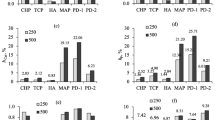Abstract
A study was conducted of the enzymatic hydrolysis of pyrophosphate and ester phosphates by extracts of bones of young rabbits. The proximal ends of humeri and distal ends of femurs were homogenized in barbital buffer (7.5 mM) at pH 7.4. The extracted pyrophosphatase activity had acid and alkaline pH optima. The acid pyrophosphatase activity at pH 5.0 was independent of magnesium up to a concentration of 3 mM and was inhibited by an excess of this ion. Pyrophosphatase activities at both pH 5.0 and 7.4 were inhibited by fluoride. The Michaelis constant of pyrophosphatase with pH 5.0 optimum activity was 1.4×10−3 M. The bone extract, when loaded on a column of Sephadex G-200 and eluted with barbital buffer (7.5 mM) at pH 7.4 containing 1% sodium chloride, allowed a separation of the two pyrophosphatase activities; that at pH 5.0 optimum activity was associated with acid phosphatase activity. Results of experiments of the two pyrophosphatase activities and alkaline phosphatase in bones of rabbits as they aged from 5 to 60 days are presented.
Résumé
L'hydrolyse enzymatique du pyrophosphate et des esters phosphates est étudiée à l'aide d'extraits d'os de jeunes lapins. Les extrémités proximales de l'humérus et les extrémités distales des fémurs sont homogénéisées dans un tampon barbital (7.5 mM) à pH 7.4. L'activité de la pyrophosphatase extraite a des pH optimaux acide et alcalin. L'activité en pyrophosphatase acide, à pH 5.0, est indépendante du magnésium jusqu'à une concentration de 3 mM et est inhibée par un excès de cet ion. Les activités de la pyrophosphatase, à pH 5.0 et 7.4, sont inhibées par le fluorure. La constante de Michaelis de la pyrophosphatase, au pH optimum de 5.0, est de 1.4×10−3M. L'extrait d'os, placé dans une colonne Sephadex G200 et élué avec un tampon barbital (7.5 mM) à pH 7.4, contenant 1% de chlorure de sodium, permet une séparation des deux activités de pyrophosphatase à pH 5.0, l'activité optimale est associée avec une activité de phosphatase acide. L'activité des deux pyrophosphatase alcaline des os de lapins est étudiée de l'age de 5 à 60 jours.
Zusammenfassung
Die enzymatische Hydrolyse von Pyrophosphat und Phosphatestern wurde an Knochenextrakten von jungen Kaninchen untersucht. Proximale Humerus- und distale Femurteile wurden in Barbitalpuffer (7.5 mM) bei einem pH von 7,4 homogenisiert. Die somit extrahierte Pyrophosphataseaktivität hatte ein saures und ein alkalisches pH-Optimum. Die saure Pyrophosphataseaktivität bei pH=5,0 blieb durch Magnesiumzusatz bis zu einer Konzentration von 3 mM unbeeinflußt und wurde durch einen Überschuß dieses Ions inhibiert. Beide Pyrophosphataseaktivitäten bei pH 5,0 sowie bei pH 7,4 wurden durch Fluoride inhibiert. Die Michaeliskonstante der Pyrophosphatase mit maximaler Aktivität bei pH=5,0 betrug 1,4·10−3M. Wenn der Knochenextrakt durch eine Sephadex G-200-Säule gegeben und die Kolonne anschließend mit einem Barbitalpuffer (7.5 mM) bei pH 7,4 mit Zusatz von 1% Natriumchlorid eluiert wurde, konnten die beiden Pyrophosphataseaktivitäten getrennt werden; diejenige mit einem Aktivitätsoptimum bei pH 5,0 zeigte ebenfalls die Aktivität einer sauren Phosphatase. Die Resultate der Aktivitätsbestimmung der beiden Pyrophosphatasen und der alkalischen Phosphatase in Kaninchenknochen in der Wachstumsperiode zwischen 5 und 60 Tagen werden mitgeteilt.
Similar content being viewed by others
References
Amstrong, W. D., Carr, C. W.: Physiological chemistry laboratory directions, p. 112–113. Minneapolis, Minnesota: Burgess Publishing Company, 1963.
Bailey, K., Webb, E. C.: Purification and properties of yeast pyrophosphatase. Biochem. J.38, 394–398 (1944).
Bauder, D. R.: Studies on a soluble protein in the erythrocyte stroma. M. S. Thesis. Minneapolis, Minnesota: University of Minnesota 1968.
Fiske, C. H., Subba Row, Y.: The colorimetric determination of phosphorus. J. biol. Chem.66, 375–400 (1925).
Fleisch, H., Neuman, W. F.: Mechanism of calcification: Role of collagen, polyphosphates and Phosphatase. Amer. J. Physiol.200, 1296–1300 (1961).
—, Schibler, D., Maerki, J., Frossard, I.: Inhibition of aortic calcification by means of pyrophosphate and polyphosphates. Nature (Lond.)207, 1300–1301 (1965).
—, Maerki, J., Russell, R. G. G.: Effects of pyrophosphate on dissolution of hydroxyapatite and its possible importance in calcium homeostasis. Proc. Soc. exp. Biol. (N.Y.)122, 317–320 (1966).
Kornberg, A.: Reversible enzymatic synthesis of diphosphopyridine nucleotide and inorganic pyrophosphate. J. biol. Chem.182, 779–793 (1950).
Linhardt, K., Walter, K.: Methods of enzymatic analysis, p. 783 (editor: Bergmeyer, H. U.) New York: Academic Press, Inc., 1965.
Lowry, O. H., Rosebrough, N. J., Farr, A. L., Randall, R. J.: Protein measurement with the folin phenol reagent. J. biol. Chem.193, 265–275 (1951).
Moss, D. W., Helen Eaton, R., Smith, J. K., Whitby, L. G.: Association of inorganic pyrophosphatase activity with human alkaline phosphatase preparations. Biochem. J.102, 53–57 (1967).
Perkins, H. R., Walker, P. G.: The occurrence of phyrophosphate in bone. J. Bone J. Surg.B40, 333–339 (1958).
Pynes, G. D., Younathan, E. S.: Purification and some properties of inorganic pyrophosphatase from human erythrocytes. J. biol. Chem.262, 2119–2123 (1967).
Stetten, D., Jr.: Biosynthesis and pyrophosphate. Amer. J. Med.28, 867–870 (1960).
Author information
Authors and Affiliations
Additional information
This investigation was supported by Grant DE-1850 from the National Institute of Dental Research, National Institute of Health, Bethesda, Maryland.
The authors wish to acknowledge the help of Miss Doris Bauder in the preparation of the Sephadex columns.
Rights and permissions
About this article
Cite this article
Vatassery, G.T., Singer, L. & Armstrong, W.D. Hydrolysis of pyrophosphate and ester phosphates by bone extracts. Calc. Tis Res. 5, 189–195 (1970). https://doi.org/10.1007/BF02017548
Received:
Accepted:
Issue Date:
DOI: https://doi.org/10.1007/BF02017548




